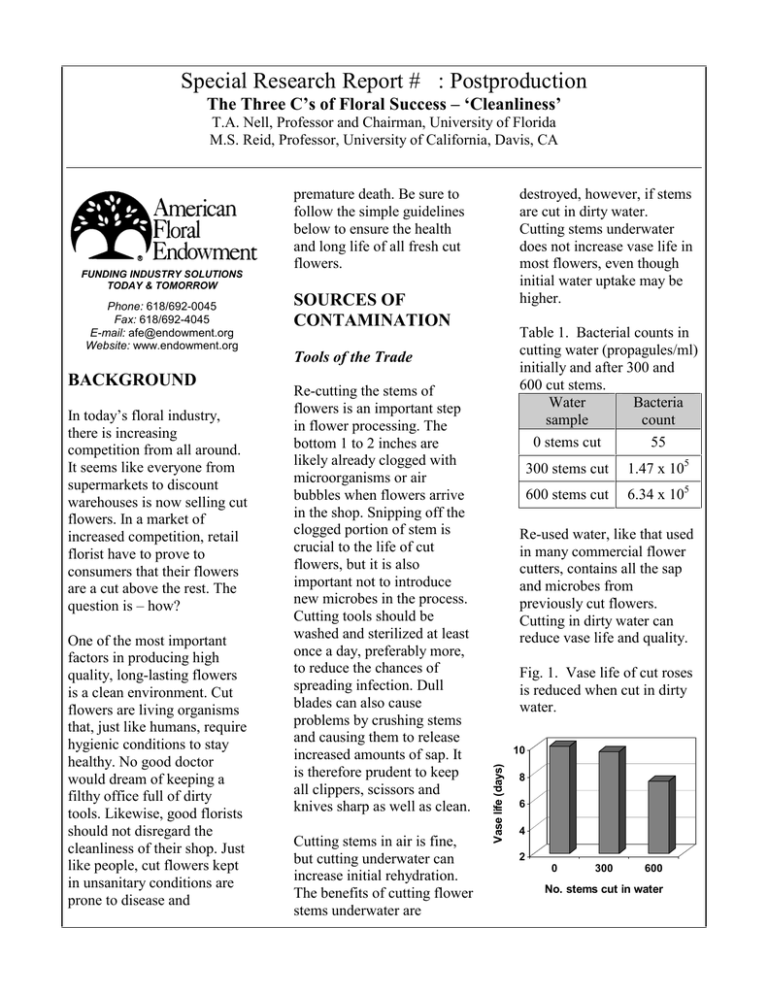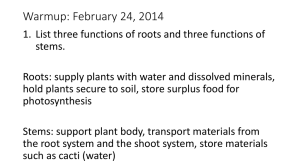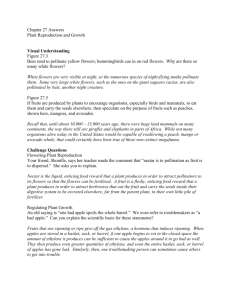Special Research Report # : Postproduction
advertisement

Special Research Report # : Postproduction The Three C’s of Floral Success – ‘Cleanliness’ T.A. Nell, Professor and Chairman, University of Florida M.S. Reid, Professor, University of California, Davis, CA Phone: 618/692-0045 Fax: 618/692-4045 E-mail: afe@endowment.org Website: www.endowment.org BACKGROUND In today’s floral industry, there is increasing competition from all around. It seems like everyone from supermarkets to discount warehouses is now selling cut flowers. In a market of increased competition, retail florist have to prove to consumers that their flowers are a cut above the rest. The question is – how? One of the most important factors in producing high quality, long-lasting flowers is a clean environment. Cut flowers are living organisms that, just like humans, require hygienic conditions to stay healthy. No good doctor would dream of keeping a filthy office full of dirty tools. Likewise, good florists should not disregard the cleanliness of their shop. Just like people, cut flowers kept in unsanitary conditions are prone to disease and SOURCES OF CONTAMINATION Table 1. Bacterial counts in cutting water (propagules/ml) initially and after 300 and 600 cut stems. Water Bacteria sample count 0 stems cut 55 Tools of the Trade Re-cutting the stems of flowers is an important step in flower processing. The bottom 1 to 2 inches are likely already clogged with microorganisms or air bubbles when flowers arrive in the shop. Snipping off the clogged portion of stem is crucial to the life of cut flowers, but it is also important not to introduce new microbes in the process. Cutting tools should be washed and sterilized at least once a day, preferably more, to reduce the chances of spreading infection. Dull blades can also cause problems by crushing stems and causing them to release increased amounts of sap. It is therefore prudent to keep all clippers, scissors and knives sharp as well as clean. Cutting stems in air is fine, but cutting underwater can increase initial rehydration. The benefits of cutting flower stems underwater are 300 stems cut 1.47 x 105 600 stems cut 6.34 x 105 Re-used water, like that used in many commercial flower cutters, contains all the sap and microbes from previously cut flowers. Cutting in dirty water can reduce vase life and quality. Fig. 1. Vase life of cut roses is reduced when cut in dirty water. 10 Vase life (days) FUNDING INDUSTRY SOLUTIONS TODAY & TOMORROW destroyed, however, if stems are cut in dirty water. Cutting stems underwater does not increase vase life in most flowers, even though initial water uptake may be higher. premature death. Be sure to follow the simple guidelines below to ensure the health and long life of all fresh cut flowers. 8 6 4 2 0 300 600 No. stems cut in water Fig. 2. Leaf damage increased on mums when cut in dirty water. Leaf damage (%) 25 20 15 10 5 by submerging them in a detergent that contains a disinfectant. When using a non-sterilizing detergent, dip buckets in a solution of 1 part bleach to 10 parts water. Also, use white buckets to make cleaning simple - dirt is easy to see on the light surface. Cleanliness is a necessary ingredient in all aspects of floral practices to eliminate microbial contamination and disease and to maximize quality and vase life. Following the guidelines listed below will help to ensure a clean environment. Cleanliness Guidelines 0 0 600 No. stems cut in water The likelihood of infections and blocked stems can increase when water is not clean. When cutting stems underwater, be sure to use fresh water for each bunch of flowers. Buckets It is important to clean and disinfect buckets and tubs between each and every batch of flowers processed. Flower stems contain cells full of sugary sap that is released when flowers are cut. This sap bleeds into solutions in buckets where it feeds the yeast, microbes and other microorganisms found on cut flower stems, causing them to multiply. These organisms are sucked into the stem where they block water uptake. The larger and more plentiful the organisms, the more clogged the flower stems become. Use a commercial antibacterial cleaning solution and a brush to sterilize and scrub buckets. Clean and sterilize buckets in one step To make sure clean buckets and tubs stay that way, do not place clean buckets on the floor before stacking. The floor is rife with microbial organisms, and clean buckets are tainted when buckets that have been on the floor are placed inside them. Instead, either stack buckets as soon as they are removed from the cleaning solution so that only one bucket touches the ground or place buckets on a cleaned and disinfected cart to dry before stacking. Coolers Another hot spot for problematic organisms is the cooler. If coolers are not cleaned properly, they can become a haven for spores of the grey mold Botrytis. Be sure to sterilize the floors, shelves and walls of coolers with either an anti-bacterial cleaner or a bleach solution (1 part bleach to 10 parts water) every four to six weeks or sooner if needed. In addition, rid coolers of dead flower parts such as dropped leaves and petals on a daily basis. CONCLUSIONS * Wash hands frequently * Sterilize cutting tools * Change cutting water for each bunch of flowers * Keep buckets clean * Keep coolers clean * Remove dead flower parts IMPACT TO THE INDUSTRY Success in the floral retailing industry is dependent upon having quality product for consumers. Keeping shops clean allows florists to provide consumers with flowers that are not just alive, but that are thriving. Flowers processed and stored in a clean environment will reward their kind treatment with higher quality and longer lasting blooms. This translates directly into satisfied customers and more business for floral shops. Contact: tnell@mail.ifas.ufl.edu msreid@ucdavis.edu 2004 © Copyright The American Floral Endowment. All Rights Reserved.







